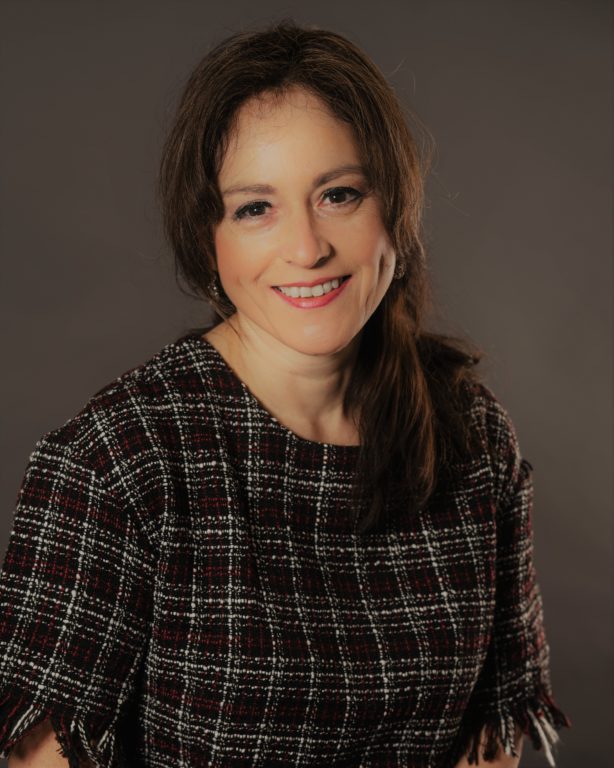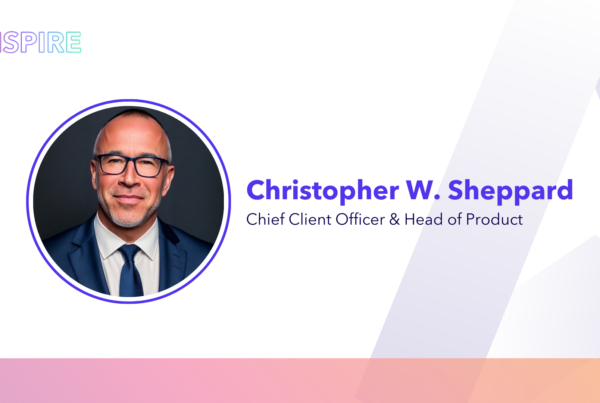Recently, I had the pleasure of speaking with Adriana Bitoun.

Adriana is currently the Director of Advancement Services at the U.S. Naval Academy Foundation. She has performed a variety of roles within development, from gift solicitation and processing to donor relations and communications. Before joining the United States Naval Academy Alumni Association and Foundation, Adriana worked at the University of Cincinnati Foundation and the California State University system. She holds a master’s of accountancy from the University of Cincinnati and has a bachelor’s degree in computer science, a post-baccalaureate degree in industrial operations, and is a certified data scientist.

Adriana Bitoun
Adriana’s work in advancement begins with a romantic start. After she finished college, she became a flight attendant and met her husband, who was an airport manager in the United States. They got married and she moved from Mexico to the United States, where her first job in fundraising was stuffing envelopes for an annual giving campaign.
As Adriana describes it, “I was completely unaware of the field philanthropy at the time. Mexico doesn’t have higher education philanthropy like the United States does. But I had very good mentors in philanthropy where I worked at Loyola Marymount University Law School. Also, with my degree in Computer Science, I started connecting some dots, doing queries and automating some processes. From there, my career just grew. I worked in the California University system, where I worked for ten years. Then I moved to the midwest and had the pleasure of working for the University of Cincinnati Foundation, and got a Master’s in Accounting from the University of Cincinnati. Then I transitioned to the U.S. Naval Academy Foundation.”
At the University of Cincinnati Foundation, Adriana worked in advancement services doing data management, gift processing, and gift agreements, among other tasks. She had a knack for finding process efficiencies. At the U.S. Naval Academy Foundation, she is the liaison with the Naval Academy, so besides doing regular advancement services, she now oversees donor stewardship and relations.
Caitlin Scarano: How do you approach stewardship?
Adriana Bitoun: Many people see stewardship as what happens after a gift is made. In my perspective, stewardship is another way of cultivation and solicitation, because you need to communicate with your donors to encourage that next gift. It is critical because, if something is not done right, you could lose that donor. And, if something is done correctly, that donor could become loyal and engaged long term. The Naval Academy is different because the sense of loyalty and purpose from their alumni feels different than alumni at a regular higher education institution. From what I’ve experienced, the Academy alumni are really invested in and loyal to the growth and development of current students. So that changes the stewardship landscape entirely. Now, it is more of a really close relationship and deeper connection with the alumni.
Caitlin: How do you approach stewardship in a way that is authentic and offers the alumni something? How do you ensure it is a two-way relationship?
Adriana: Stewardship doesn’t start with the size of the gift. It starts with who the donor is regardless of the size of the gift. When you are in stewardship and you really know your donors in-depth, you think about the potential they have to impact the institution.
You want to deepen that connection, inform them what good is happening at the institution, entertain their interests and let them know that those interests are important to the institution. You also want to let them know there is more they could be doing if they give you the opportunity to learn more about them and their interests. Learning who your donors are is a way of cultivating them.
Caitlin: What are the techniques or tools you use to find out about prospective donors and how do you know if that data is accurate?
Adriana: Pair with data companies or vendors that are experts in knowing or finding information about your prospective donors that go beyond the gift, such as other philanthropic interests, which is a common one. More difficult data points might be something like whether the prospect owns a plane or not.
Through our data enrichment solutions, Affinaquest offers every field of personal information you need to effectively identify and engage your prospects and donors. We combine our expertise in identifying, formatting, and flagging data to deliver quality updates on hundreds of data fields. Contact us to learn how we can help your organization!
Adriana: When you start connecting those dots in an intelligent manner, you can get a picture of what the prospect is looking for—for example, recognition, to make an impact, or to honor someone’s legacy. Gather that information and pair it with your internal knowledge of the prospects and donor, then start building segments or categories of them. There will be data a company that may never be able to gather but your institution already has, such as the knowledge held by a good development officer who has been around for a decade or more. Sometimes gift processors notice things that nobody else does, like a donor’s pattern of giving or communication preferences. That is when you pair internal knowledge with a company’s information and develop a system of prioritization to be able to talk to your prospect and donors about what really matters to them.
In my current role, I’m not asking for gifts but I ensure that those asks are for the right amount and occur at the right time. I train my team to review data and do analytics frequently. You might have results from a data vendor, but you have to match and review those results constantly to make sure you know who to ask for what. For example, if a donor recently went through a divorce, you probably won’t ask them for another gift. You also have to be aware of the circumstances happening in the world. With COVID-19, many prospects and donors lost their businesses, so are they going to honor a large ask right now? Probably not. You need to be on top of what is going around in your environment and how that environment is impacting your donors. It is a little bit of science and a bit of intuition.
Caitlin: What are your techniques for maintaining data integrity and accuracy?
Adriana: As a general rule of thumb, you need to maintain your data and routinely update addresses. Employment data can be super important as an indicator of giving. But I’ve found that isn’t true for every institution, for some other institutions’ other data points, like having a good email address or home or cell phone numbers, are more relevant for their connections. So, identifying whatever data points matter most to your particular institution and keeping those up to date are essential. At a previous institution I worked at, we had good employment data, but it had not been updated in a few years. We had one prospect listed as an analyst and they became, over the years, vice president of data analytics at a large company. Only after we did a data append did we find out his most recent title and discover we’d been missing that opportunity for a number of years.
Caitlin: What is the most important lesson you’ve learned in advancement or the most meaningful experience you’ve had in this field?
Adriana: At the very beginning of my career, I learned the most important lesson: you need to know who you are talking to and know your prospective donors really well. I was in charge of sending pledge reminders and my Excel spreadsheet got messed up, so some of the addresses were wrong, so I sent the reminders to the wrong addresses. This happened to a segment of lawyers, some of whom spoke to the dean. The dean, who was very generous, asked me what happened and I told him. He then asked me to call all the donors and tell them what happened and apologize. It was about 100 individuals. One of them happened to be a judge in one of the largest courts in Los Angeles.
He said, ‘I understand you made a mistake, but, to me, the institution made a mistake. I don’t want to give to the institution any more because I wasn’t treated with the care that I wanted.’ This was a big lesson for me because people who really care about the institution will be very vocal. They care about how you treat them, what information you have about them, and how you talk to them. That is why I think stewardship is so key in the donor relationship.
Another example, in terms of mentoring, occurred when I was working with a very generous woman who was a director of alumni relations. She was also in charge of annual giving and scholarship awards. We were trying to figure out who to award money to. She taught me that in all that we do there has to be a human component, not just a number—a student number or a gift amount. In doing philanthropy, you could be impacting the life of a person forever. We learned that when we awarded a scholarship to a DACA student who didn’t have the means to finish his last semester. We awarded that scholarship money to him and he was able to finish college and his life changed.
Caitlin: Fundraisers have dual pressure to manage massive amounts of data and individual relationships. What do you make of this big challenge in the field of advancement?
Adriana: When we talk about metrics for fundraisers, we say that fundraisers should have X amount of people in their portfolio that have to be contacted within a certain amount of time, which is good; it helps fundraisers focus. But sometimes people land in a fundraiser’s portfolio who they have no clue about—what their interests are or what could engage them with the organization. You could go tell them the institution is fabulous and awarding all this scholarship money, but maybe that is not where the prospect’s interest lies. You need to learn about that person and the only thing you have is the data. Here at the Academy, the approach is very personal. So we need to come in with key data points that could inform who the donor is. That data, at the same time, could be very sensitive and has to be kept with confidentiality. It is a balance and a tension. You have to remain ethical and professional and, at the same time, be able to produce results for the institution.
Caitlin: How should women approach the particular challenges of working in advancement?
Adriana: You have to understand that, as women, there are fields that are not entirely open to us. You may be working with people who might not perceive you as equal or want to take direction from you. When we as women try to make strides in those kinds of fields, we have to be twice as good. Not because we want to be dismissive of others, but because we might be dealing with professionals who question the decisions we make or view us as competition. Sometimes women have a different leadership style and we might be perceived as weak or soft or nice, because we smile or the way we are. We can both lead with our feminine side and excel at what we do.
Caitlin: How has COVID-19 impacted your work and changed how you’re thinking of the future of the field?
Adriana: You have to be a visionary, think ahead, and take advantage of all the tools out there to make your work easier. One of the biggest challenges of fundraising is that it is so relational; fundraisers used to do this by having visits with prospects and donors. COVID-19 took that away from us. How can we develop deep relationships in the electronic era? How can we take advantage of the tools we have at hand to really make an impact?
This is something people are really mulling over. I can tell you that the phone still exists; you can still call your donors! You may find prospects who aren’t as comfortable with Zoom, but you still need to engage them. It is not just about making the ask, but making the human connection with that person, but now that may not be in-person. This will be the biggest challenge in the years to come. We need to be more creative and use not just electronic means, but means that help donors remember that we are still here. In this COVID-19 reality, how can we make the donors know we still care about them? Handwritten notes are great for this. Or, for tech-savvy donors, using those electronic or virtual touchpoints are essential. Again, you have to be a visionary and find ways where your work can be done remotely. We cannot be not in business forever. What can be done electronically? Or, what can be done differently?
Caitlin: Do you have any final thoughts you’d like to share?
Adriana: Overall, we need to keep donors at the center of our minds and institutions at the center of our minds and find ways to connect regardless of the environment that we’re in. If I can be of any help on these topics, your readers can reach me at adriana.bitoun@usna.com.
I want to thank Adriana for taking the time to speak with me and wish her luck in her new position with the U.S. Naval Academy Foundation!
Doing interesting work in the field of advancement or data analytics in fundraising? We’d love to interview you! Contact me at cscarano@affinaquest.com.




